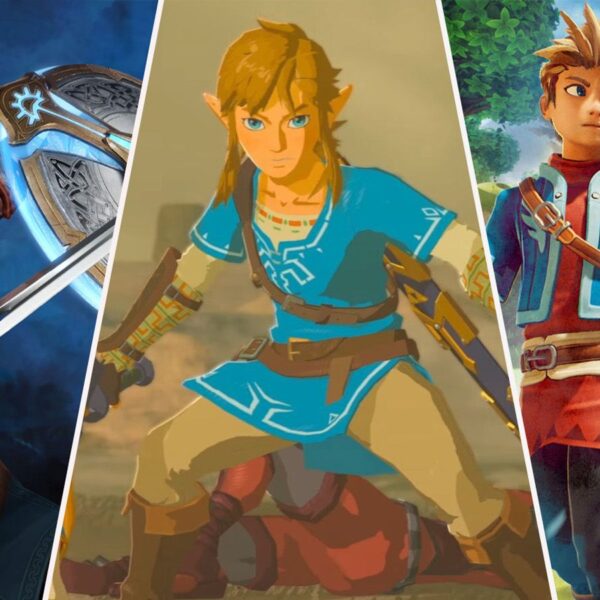Most Immersive Open World Games

Many fans were heartbroken to hear that masterclass game developer Hideo Kojima wouldn’t be working on the critically acclaimed Metal Gear Solid series any longer but were quickly placated to learn the iconic creator was opening his own studio. His first foray into the world of video games as an untethered designer was Death Stranding. Although it’s a bit avant-garde for some, the world that Kojima created is nothing short of spectacular, especially from an immersion standpoint. Players get to control Sam, a “futuristic delivery man” portrayed by the talented Norman Reedus of Walking Dead fame. Although Death Stranding is superbly strange, it’s also incredibly enthralling (although some may find it hard to enjoy its quirky and slow-paced gameplay). Ultimately, this title is not for everyone, but it is definitely worth a look, if only to appreciate its world. 41 Avatar: Frontiers Of Pandora Beautifully Recreates Pandora While not the be-all and end-all of what makes a great game, graphics do matter. Would Avatar: Frontiers of Pandora have made the grade if it was not so gorgeous? Probably not, and that is not an indictment of the rest of the experience. It is just that the title’s visuals are by far its most striking feature, and they bring to fruition a vibrant, lively, and reactive alien world that is packed to the brim with jaw-dropping vistas. The game is fully aware that its main selling point is its world, and it goes out of its way to ensure nothing distracts from its beauty. The immersion goes beyond just the visuals though, as Frontiers of Pandora also does an admirable job of making players feel like they are controlling huge alien creatures that tower over humans. While the combat is not that far removed from the typical Ubisoft first-person experience, the game’s heightened mobility gives everything a different and refreshing flavor. 40 Dragon’s Dogma 2 The Joy Of Taking Things Slow Similar to its predecessor, Dragon’s Dogma 2 is not the prettiest or biggest open-world game on the market. The main storyline is little more than serviceable, and the enemy selection is decent but a touch limited. Most of the map consists of roads, caves, and mountains, which can get repetitive at times. If someone wants to dash through the campaign, they just need to stick to the primary paths and will generally be fine. Despite all that, Capcom’s RPG is impressively immersive, and that largely stems from its willingness to force players to take things slow. While possible with some prep, Dragon’s Dogma 2 makes fast-travel inconvenient enough that players will likely restrict it to special case scenarios. Even though making a beeline for the next plot point is a viable way to play the game, doing so is not encouraged; in fact, an argument could be made that Dragon’s Dogma 2 truly comes alive when quests are ignored in favor of exploring off the beaten path. Before long, players will find themselves running into random encounters that feel like genuine emergent experiences, rather than enemies that are forever pinned to one spot on the map. 39 The Saboteur Fresh Take On WW2 Pandemic Studios was great. The developer knew how to combine cool settings with addictive and accessible gameplay while telling unique and (occasionally) comedic stories. While perhaps not “immersive” in the traditional sense, both Mercenaries games are highly entertaining sandbox projects that feature some of the genre’s best-ever destruction. The Destroy All Humans! games also offered fun smaller-scale twists on the open-world format. The developer could also handle non-sandbox projects masterfully, as shown by Star Wars: Battlefront and Full Spectrum Warrior. Even The Lord of the Rings: Conquest deserves praise for its presentation, despite not being among the franchise’s best titles. EA shut down Pandemic in November 2009, a month before the developer’s final game hit store shelves. Putting everything else aside, The Saboteur saw Pandemic go out on a high note that is still worth revisiting to this day, as long as new players have a fondness for PS3-era open-world projects that take fairly heavy inspiration from the first few 3D GTAs. Surprisingly, very few open-world games have tried covering World War 2, and The Saboteur is extra special due to taking place in Nazi-occupied Paris. The city’s recreation is historically accurate, albeit stylized through artistic choices like depicting yet-to-be-liberated areas in black and white (and introducing color as a reward for liberating them). The Saboteur has a few shortcomings and enjoyable gameplay that does not break any new ground. Nevertheless, its unique and immersive setting is more than enough to keep things interesting, and it is hardly the game’s only strong suit. 38 Prey Metroidvania Horror Masterpiece Prey is not an open-world game in the sense that players can immediately explore the entire map, but they will be able to return to previous areas. Essentially, Arkane created a 3D Metroidvania, and a fantastic one at that. Prey is an immersive sim set within Talos 1, a quite large space station that has been taken over by an alien threat. Talos 1 is a masterclass of world design, with each area telling a story through its environment. The map is interconnected, not only in terms of exploration but also in consistency. Even though the campaign mainly takes place after the station has become a wasteland, it is easy to buy Talos 1 as a real place. 37 Shenmue The Daily Cycle Before Shenmue arrived for the Sega Dreamcast back in 1999, the concept of open-world games was still very much in its infancy. While most other developers were still trying to figure out how to make the leap from 2D to 3D though, Yu Suzuki was instead focused on creating one of the most immersive and realistic video game worlds of all time; and boy, did he succeed. Set in the late eighties, the game allows players to explore parts of Yokosuka; a small city in Tokyo’s Kanagawa prefecture. All the NPCs that they’ll encounter are fully voiced and have their own well-fleshed-out identities and daily routines. The game even utilizes historic geographical data to ensure that the in-game weather matches that of the period in which the story takes place. 36 Microsoft Flight Simulator Travel Across The World Microsoft Flight Simulator is not for everyone, but if the game clicks with someone, it might just become one of their favorites. As the title implies, this project is all about simulating the flying experience, and realism is prioritized to quite an extent. That said, the game does provide players with some options to neutralize the difficulty. Alongside a mode revolving around specific flight plans, Microsoft Fight Simulator also includes the entirety of Earth as a world map, permitting players to just pick a location and fly there. Outside of landing the planes, the map can only be interacted with from the sky; consequently, Microsoft Flight Simulator might not be exactly what most people are looking for in an immersive open-world game. 35 Sons Of The Forest Survive Among The Locals Sons of the Forest is the sequel to 2018’s The Forest, which is a great survival open-world game in its own right. After a stint in early access, the project made its full debut in 2024, launching in great shape if someone is mainly interested in the survival gameplay loop rather than the story. Once again, players find themselves stranded on a beautiful but hostile island that is home to cannibals (and other natives), who might or might not be aggressive toward the outsider. Sons of the Forest is punishing and addictive. While encouraging exploration, the island is also packed to the brim with things that can spell someone’s doom, and discovering these dangers often produces a playthrough’s most enjoyable moments. Endnight’s project is a full-blown survival game set in a challenging and immersive world. 34 Kenshi An Unforgiving Post-Apocalyptic Open-World Survival RPG Kenshi is an ambitious game that drops people into a massive open-world and challenges them to make their own way. After creating a group of starting characters, players are not given much direction, so they must venture out into the unknown as they gradually develop their party’s skills through activity. They can build houses, farm goods, and establish settlements, just to name a few things. Although not entirely without written quests, Kenshi largely relies on its established mechanics to organically inspire stories built upon a user’s personal ventures. The result is a punishing and overwhelming experience that is also immersive and frequently deeply satisfying. 33 Batman: Arkham City Become The Batman “Immersive” is not a synonym for “realistic.” Rocksteady’s Arkham games do not pretend to be grounded crime dramas; however, in terms of making players feel like they are the Dark Knight, they are almost flawless. An argument could be made that Arkham Knight represents the franchise’s peak in open-world design, but the polarizing Batmobile sections can pull someone out of the experience if they do not enjoy them. Arkham City has no such issue, and the game nails almost everything else. After being purposefully arrested and imprisoned, Batman finds himself in the eponymous Arkham City, a large-scale prison that serves as the home of Gotham’s worst and most iconic criminals. Armed with an impressive arsenal of tools, DC’s Caped Crusader investigates Hugo Strange’s Protocol 10, all the while engaging in a plethora of side content. Arkham City’s nature means its streets are mostly devoid of NPCs, except for thugs who have a date planned with Batman’s fists. While this emptiness would be frustrating in most open-world projects, Arkham City provides narrative justification for this decision, helping to enhance the immersion. 32 Hogwarts Legacy Detailed Recreation Of Hogwarts Avalanche’s Hogwarts Legacy rode the hype train all the way to a wildly successful launch. Harry Potter games are nothing new, but great ones are rare; in many ways, the 2023 release is the first title to properly take advantage of the franchise’s gaming potential. Regardless of someone’s feelings for Harry’s story, Harry Potter’s universe is generally regarded as fantastic, and Hogwarts Legacy enables fans to immerse themselves in a world filled with magic, mystery, and charm. Even if its story is nothing to write home about and everything outside Hogwarts leaves something to be desired, the game nails its aesthetic and recreation of the eponymous academy, and players can spend dozens of hours living out their Wizarding World fantasies. 31 Yakuza 0 (& Most Yakuza Games) Size Does Not Matter Nowadays, the mantra for open-world games seems to be that “bigger is better”, but Yakuza has constantly proven that is not really the case. Yakuza 0 takes place in two districts called Kamurochō and Sotenbori, neither of which is particularly huge. However, these settings nevertheless effectively complement the main story and also provide players with a playground to participate in entertaining optional content. The Yakuza games blend realism with over-the-top silliness fit for B-movies, and the open-world tends to focus on the former. These maps are packed with arcades, restaurants, and bars, along with containing plenty of side activities and mini-games. 30 Mafia 2 Era-Accurate City This one is a different case than all the other games on this list as Mafia 2’s open-world is mostly set dressing that does not offer much to do outside of driving from one main mission to the next. This is not a map designed to distract people for hours on end. However, in terms of realism, Mafia 2 does a fantastic job of recreating the aesthetic of the late 1940s and early ’50s. The cars, slums, and shops all come together to craft an immersive landscape soaked in historical accuracy (despite the game taking place in a fictional city), albeit one that cannot be interacted with in any significant way. 29 Outward Hard-As-Nails Open-World About Being An Average Person An acquired taste, Outward somehow combines many standard ideas found in action RPGs in a way that gives the game an entirely unique feel. For one, this open-world title incorporates survival elements like a hunger meter, and players will need to keep a close eye on these mechanics as they are not especially forgiving. Outward also opts against the typical “save the world” premise, focusing instead on a more mundane debt-clearing quest to get players started. This storyline is primarily there to incentivize the main character to begin adventuring, at least until they no longer need a reason to justify heading out into the unknown. Outward is all about exploration and discovery. Whenever heading out into the world, players need to prepare themselves for their travels as they could quickly find themselves stuck in a dire situation. The map can be accessed in its entirety right from the start, even though some sections are obviously designed for higher-level players. Outward has its share of issues, such as underwhelming combat, that could be deal-breakers for some people, but the game’s open-ended structure is a huge positive in its favor. 28 Gothic 1 & 2 Fully-Realized World & NPCs Piranha Bytes achieved open-world perfection with the original two Gothic games, so much so that the developer spent the next two decades trying to recapture the same magic, to mixed results. The first entry is impressive and arguably features the best story in the trilogy, but in terms of open-world design, Gothic 2 is up there with the genre’s best projects. Set on an island, the campaign finds the Nameless Hero going on a quest to defeat the dragons, a journey that will take them all across Khorinis. The central storyline is nothing all that special, but Gothic 2 shines in its minute details. NPCs feel like they are leading lives within this world, and they have their own things going on that have nothing to do with the protagonist. Featuring an impressive range of customization and progression options, Gothic 2 encourages players to craft their ideal adventurer, granting them endless choices in how they fight, live, and explore. Although fairly small by modern standards, Khorinis is a joy to traverse, provided someone does not mind the occasional difficulty spike. 27 Sea Of Thieves Live The Pirate Life As Part Of A Crew Rare’s Sea of Thieves garnered a mixed reception upon launch due to a lack of content. More than 5 years later, the pirate-themed game is still going strong, a triumph credited to the developer’s commitment to the project and the community’s appreciation of that work. Sea of Thieves can be played solo or as part of a crew, and both iterations have their positives; however, the latter opens up more avenues. The game takes place in a shared world, so groups of players can engage in PvP as they try to sink each other’s vessels. Although not especially difficult, Sea of Thieves encourages exploration and self-reliance. Treasure seekers will need to read and figure out maps for themselves rather than just follow a waypoint. While on the sea, there is a sense that something could happen at a moment’s notice, challenging crews to stay on their guards at all times. 26 Final Fantasy 7 Rebirth Revisiting A Well-Known World Square Enix has dabbled in open-world design a few times, but most of these attempts left something to be desired. Final Fantasy 15 serves as a prime example, with the game featuring a beautiful but empty open-world that does not particularly complement the main story. Final Fantasy 7 Remake is fairly linear in design, despite incorporating open areas that encourage exploration. In comparison, Rebirth feels like a full attempt to incorporate an open-world, and it is comfortably the developer’s best effort at this type of project. Set after AVALANCHE leaves Midgar, the characters (and players) are quickly exposed to an expansive horizon that goes well beyond what they have ever experienced, and the sequel does a fantastic job of emphasizing the sheer freedom in front of them. Many people grew up with the original Final Fantasy 7, and as influential and masterful as that JRPG is, its post-Midgar sections are relatively small-scale. Rebirth brings these areas to life in all of their modern glory, allowing fans to immerse themselves in locations they knew but had yet to fully experience. 25 Rust Unforgiving Survival Sandbox Rust often gets criticized due to the large number of players who shoot on sight and raid other peoples’ bases. Though this kind of behavior can make things difficult for new players, it’s arguably exactly what one should expect from a post-apocalyptic wasteland and therefore helps to make the game’s open-world a lot more immersive. When all’s said and done, the radiation zones and irradiated animals in Rust pose very little threat to those who know what they’re doing. The unpredictable nature of humanity, on the other hand, ensures that players need always remain on their toes, while simultaneously making the experience feel a lot more genuine than it would otherwise have been.
Categories: World
Recommended news

Best Games Like Zelda BOTW

Five things to watch in Paris on Tuesday
Authors
Popular news

How children of European officials went to school in Brussels half a century ago








